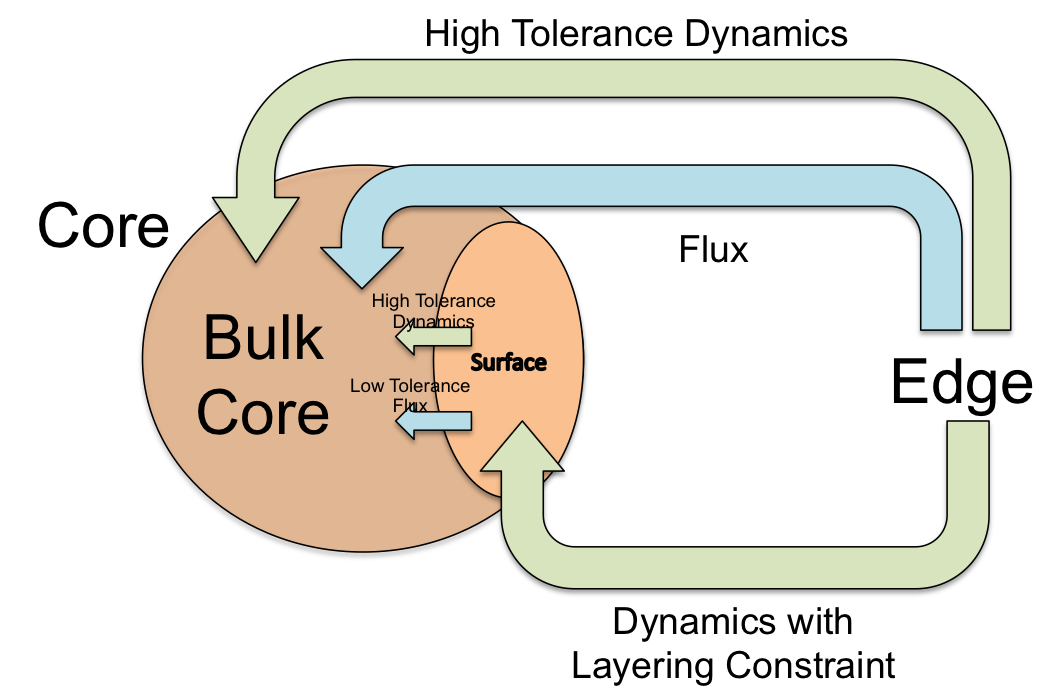3. Dynamics Criterion¶
When dealing with more complex chemical mechanisms the standard RMG flux criterion has trouble picking up key chain branching reactions and has limited guarantees that it accurately represents the concentrations of all species. The dynamics criterion is a measure of how much a given reaction affects core concentrations. This allows it to pick up key low-flux chain branching reactions and better represent species concentrations.
3.1. Calculating the Dynamics Criterion¶
Let us define rates of production \(P_i(t)\) and consumption \(L_i(t)\) for a given species \(\frac{dc_i}{dt} = P_i(t) - L_i(t)\)
Let us define a dimensionless concentration variable we will refer to as the accumulation number Ac for a given species
\(Ac_{spc,i} = \frac{P_i}{L_i} \approx \frac{\bar{c_{i}}}{c_{i0}}\)
where \(\bar{c_i}\) is the steady state concentration or more specifically the concentration at which \(P_i = L_i\) assuming \(L_i\) scales with \(c_i\) and \(c_{i0}\) is the current concentration.
This species accumulation number is a measure of how far species i is from steady state.
Since this number can only be calculated for core species, by itself it is only a measure of the behavior of species i within the reaction network.
However if we consider models with and without some edge reaction j we can define
\(\Pi_{Ac,i,j} = \frac{Ac_{spc,i,withj}}{Ac_{spc,i,withoutj}}\)
Which is a measure of how much the concentration of species i is impacted by reaction j.
In order to directly compare multiple reactions we can then sum over all core species involved in reaction j to get our criterion the dynamics number.
\(\sum_{i\in core} |Ln(\Pi_{Ac,i,j})| = Dy > \epsilon\)
3.2. Surface Algorithm¶
One common issue with the dynamics criterion is that it treats all core species equally. Because of this, if the dynamics criterion is set too low it enters a feedback loop where it adds species and then since it can’t get those species’ concentrations right it adds more species and so on. In order to avoid this feedback loop the surface algorithm was developed. It creates a new partition called the surface that is considered part of the core. We will refer to the part of the core that is not part of the surface as the bulk core. When operating without the dynamics criterion everything moves from edge to the bulk core as usual; however the dynamics criterion is managed differently. When using the surface algorithm most reactions pulled in by the dynamics criterion enter the surface instead of the bulk core. However, unlike movement to bulk core a constraint is placed on movement to the surface. Any reaction moved to the surface must have either both reactants or both products in the bulk core. This prevents the dynamics criterion from pulling in reactions to get the concentrations of species in the surface right avoiding the feedback loop. To avoid important species being trapped in the surface we also add criteria for movement from surface to bulk core based on flux or dynamics criterion. However, to avoid important species being trapped in the surface we also add criteria for movement from surface to bulk core based on flux or dynamics criterion.

3.3. Key Parameters for Dynamics Criterion and Surface Algorithm¶
toleranceMoveEdgeReactionToCoreAn edge reaction will be pulled directly into the bulk core if its dynamics number ever exceeds this value.
toleranceMoveEdgeReactionToSurfaceAn edge reaction will be pulled into the surface if its dynamics number ever exceeds this value.
toleranceMoveEdgeReactionToCoreInterruptWhen any reaction’s dynamics number exceeds this value the simulation will be interrupted.
toleranceMoveEdgeReactionToSurfaceInterruptWhen the dynamics number of any reaction that would be valid for movement to the surface exceeds this value the simulation will be interrupted
toleranceMoveSurfaceReactionToCoreA surface reaction will be pulled into the bulk core if its dynamics number ever exceeds this value. Note this is done on the fly during simulation.
toleranceMoveSurfaceSpeciesToCoreA surface species will be pulled into the bulk core if it’s rate ratio ever exceeds this value. Note this is done on the fly during simulation.
